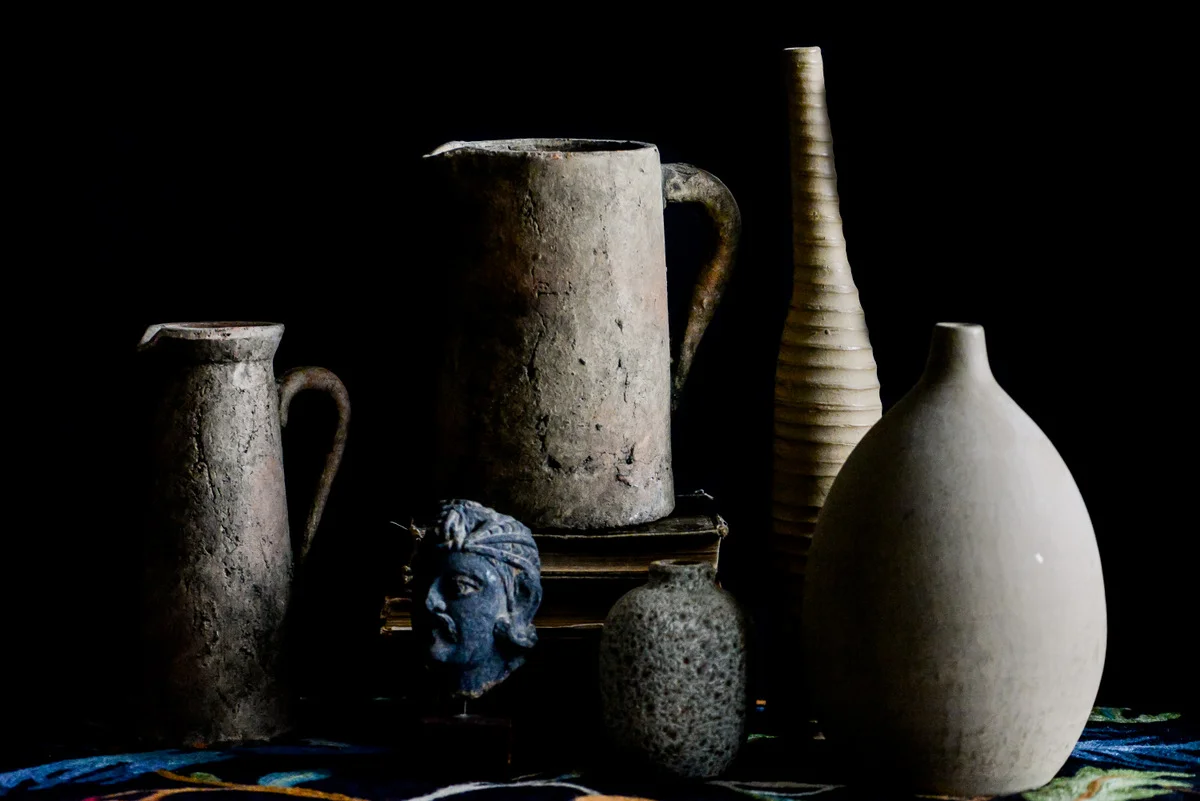Morandi, de Chirico, la Vita Silente, and the Way Things Happen
I was practicing my practice. Learning to take photos of flowers and objects is a goal I’ve set for myself. So I gathered up what was around and what was interesting to me. I set the stuff on the table. I fiddled. And after, while I was processing the photos, this is when it hit me that I’d done a sort of vague mash-up of Giorgio Morandi and Giorgio de Chirico. That’s just the way things happen in art. It’s all borrowing and stealing and forgetting and referencing and mashing things up.
It’s not hard to do this sort of homage in still life, because there are only so many configurations, shapes, types of objects. And over the years Rob has held an interest in Morandi, and of course, most still life painters have an unusual conglomeration of vessels.
If you have followed Rob and me for any length of time, you will have seen the line by Morandi, “Nothing is more abstract than reality.” (In fact Rob has a t-shirt with that on it, from a show at the Metropolitan Museum of Art, way back when). You probably know that my book, Calm Things, is named for the Japanese term for still life. In an essay, I also mention that the Italians call it la vita silente. And this term was coined by Giorgio de Chirico. In an article on a Morandi exhibit in 2015, Renato Miracco said:
“The first question we must ask ourselves when facing a painting by Morandi is: “What am I looking at?” or “What should I look at?” We could answer with a metaphor, such as: “Morandi’s paintings are self-contained islands of silence.” As I have written at various times in my essays on Morandi, what matters most in his paintings, and even more so in his drawings, are the blank spaces.
Between the forms that penetrate each other and the forms that we merely intuit lies what I have elsewhere called “the soul’s breath.””
I love the silence of still life. I love the quiet and calm of certain still lifes, the way they centre us, and lead us to the soul’s breath.
A number of poets have written about Morandi. Here is Adam Zagajewski:
Morandi
by Adam Zagajewski
Even at night, the objects kept vigil,
even as he slept, with African dreams;
a porcelain jug, two watering cans,
empty green wine bottles, a knife.
Even as he slept, deeply, as only creators
can sleep, dead-tired,
the objects were laughing, revolution was near.
The nosy watering can with its beak
feverishly incited the others;
blood pulsed wildly in the cup,
which had never known the thirst of a mouth,
only eyes, gazes, vision.
By day, they grew humble, and even took pride:
the whole coarse existence of the world
found refuge in them,
abandoning for a time the blossoming cherry,
the sorrowful hearts of the dying.
Writers on Morandi often mention that his work is poetry in paint, so it’s no wonder he attracts many poets. Charles Wright mentions Morandi in a number of poems, including, “Looking Around.”
Michael Kimmelman wrote of Morandi’s work:
“Morandi, who died at 73 in 1964 in the modest house on Via Fondazza in Bologna where he had lived his whole life with his mother (until her death in 1950) and with three unmarried sisters, devoted his career to painting pretty much the same dusty bunch of bottles, bowls and biscuit tins. He worked in a studio that doubled as his bedroom. "One can travel the world and see nothing," he said, "To achieve understanding it is necessary not to see many things, but to look hard at what you do see."
That is the message of his pictures: there is a universe in life's little things. And even when just shuffling a few humble objects around a table, unending variety and humor can be achieved through the subtlest distinctions of color and brushstroke. Look closely, Morandi instructs us. The moral implications are clear.”
Kimmelman remarks that the Morandi show is: “pure heaven.”
Umberto Eco once marvelled at, “‘how so much spirituality can be expressed… through such humble items.” And Morandi himself said, “I’m a painter of the kind of... composition that communicates a sense of tranquility and privacy, moods which I have always valued above all.”
I suppose the reason I’m conducting my own still life photography experiments is so that I can take the time to look at the little things, to look hard. And to experience a sense of tranquility. To slow down my breathing.








